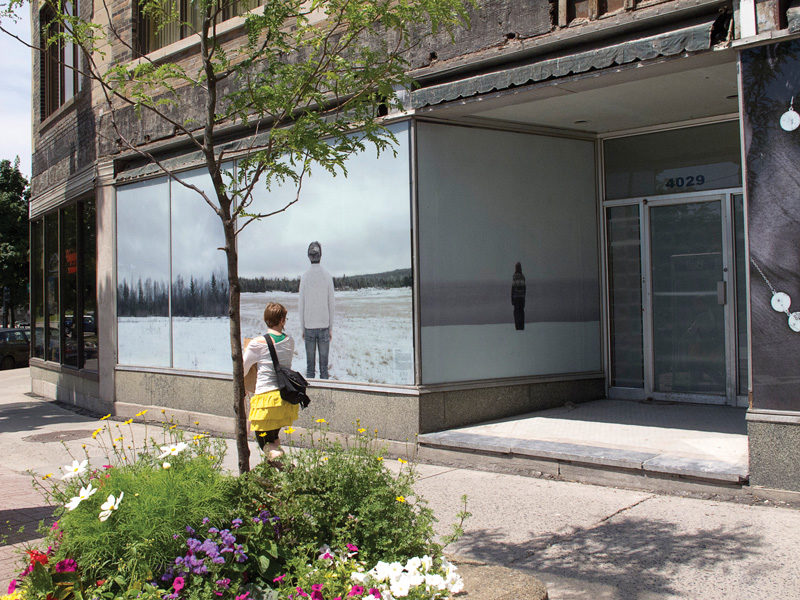[Fall 2012]
À louer / For Rent
UMA, various venues, Montreal
UMA, Montreal’s estimable Maison de l’image et de la photographie, has taken a valuable and highly laudatory initiative in seeking out vacant commercial spaces throughout Montreal and installing photographic works in their windows. What was once a forlorn blank slate of the inner city becomes a vibrant forum for the photographic image. The works remain on view until the spaces are rented or sold. Under the able direction of André Cornellier, the inner city is transformed into a Mecca for photographic artists and voyeurs alike. You turn a corner, say, onto Centre Street in Point St. Charles and happen upon three of Jessica’s Auer’s Recreational Spaces, which, with their implicit grandeur, transport you instantly to another place, another time. You emerge from the Marché Saint Jacques on Amherst, and a host of portraits of young costumed girls by Jasmine Bakalarz catch your attention. The project accomplishes several goals: it provides a forum for emerging artists who might not otherwise have a venue for their work; it turns otherwise empty spaces into magical aesthetic oases throughout the downtown core; it speaks directly to the citizens of various neighbourhoods such as Saint-Henri and the Point; and, frankly, it just plain beautifies Montreal in the best possible way: through ample helpings of art.
Some of the highlights: Jessica Auer’s three huge photographic images, installed on the walls of an empty storefront on Centre Street in Point St. Charles, take your breath away from the get-go. They are simply magnetic and pull viewers effortlessly into them: a spiral jetty; the archipelago-like outcropping of a glacier on which a lone figure stands; a mountain threshold teeming with tourists. And she holds us captivated. Her casual authority is such that we seem on the brink of an invisible abyss that has suddenly opened up above the sidewalk. Auer tells us that the images in this project demonstrate how landscape has been preserved, altered, or commodified for sightseeing. But they also possess a haunting, incommensurable, and numinous beauty. This ongoing series invites viewers to consider the socio-cultural and historical significance of these places and to interrogate the tourist’s responsibility in observing these sites. And yet their grandeur abides.
Jasmine Bakalarz, a Concordia University graduate now based in her native Buenos Aires, is featured at Marché St-Jacques. Her photographic work has focused mainly on large-scale colour portraits that deal with children’s psychological states in termsof gender identity and immediate sociocultural environment. Each portrait possesses great visual clarity, and her palette is overwhelmingly seductive. Works from several of her series are represented here in mini-retrospective fashion – from children competing in beauty pageants and ballroom dancing in North America to costumed girls in Argentina – and they refer to the depiction of aristocratic children in art history, particularly during the Baroque period. One is left with no doubt whatsoever that Bakalarz is an artist to watch.
At 3990 Notre Dame W., maverick photographer Marisa Portolese’s radiant floral tableau vivant, sounding a grace note with its flowers blowing in the wind from on high, comes from her Antonia’s Garden series, a powerful meditation on the politics of her family history. Hers is a vibrant palimpsest fraught with shadows and sundry luminosities as she courageously confronts ands works through difficult issues relating to gender, identity, displacement, and abandonment. Her gift is an innate ability to grasp lush, multilayered structures of domestic life with a deft, crisp, and altogether convincing touch. Here, she expresses the overwhelming fragility and enduring strength of life through the simple depiction of flowers in the landscape. Feaured on the exterior windows of the vast iga at 6675 Monk are works by photographer Andréanne Michon (now completing her mfa at the San Francisco Art Institute), from her Charm, Strange series (2010), that evoke the physical and psychological presence of place through portrait and landscape. Michon’s portraits are inherently civilizing, in the sense that the humanity of her subjects is always given front and centre, even when their expressions are most quixotic. Interleavening portraits with details of the natural landscape,Michon demonstrates the full measure of her gifts here.
Other significant installations, among those too numerous to describe here, include the following: at 505 Place St-Henri, Flavia Majilis dilates on portraiture and the photographic image of the body. The subjects of this series – eighteen- and nineteen-year old college students – are startlingly direct and unavoidably self-present. Given the youthful population of the Saint-Henri neighbourhood, the placement of these works here seemed sensitive and inspired. At 8582 Hochelaga, Simon Belleau’s photographs of a wolf-like white husky are mournful sentinels in opaque windows. At 8430 Hochelaga, Marie-Phillipe Boudreau uses her private life as an evocative palimpsest, and at 6615 Monk, Hans Ning offers powerful triptychs based on his childhood experiences in the context of an absent father. By the time I arrived on the scene, it seemed that one had been removed – the space rented – but the higher one was still in place. At 4029 Notre-Dame Street West, Adam Simms explores the untamed landscape of his native Newfoundland with rare eloquence and grace.
Many of the participants are Concordia graduates, and “A Louer/For Rent” is, above all, a testimonial to the high quality of the Concordia University photography department, which boasts a faculty that includes such important and diverse artists as Genevieve Cadieux, Auer, Portolese, and Raymonde April and produces cascades of promising photographic artists with each graduating class. Finally, photographic savant and UMA maestro André Cornellier deserves full credit for an event that highlights the work of some of the best and most provocative emerging and established photographic talent around.
James D. Campbell is a writer on art and independent curator based in Montreal. The author of over 100 books and catalogueson contemporary art and artists, he contributes frequently to visual arts publications across Canada and abroad.




